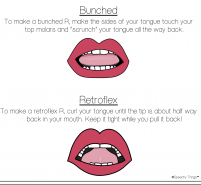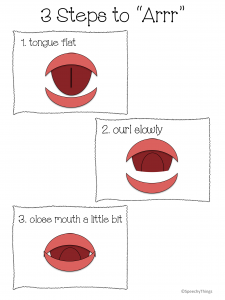Tips & Tricks for Speaking “R”
Tips & Tricks for Speaking “R”
Can you try saying “R”? If you tried that now, how many of you got it right? If it’s a ‘yes’, cheers to you, yay! But many of us have experience with a child who has struggled with his or her /r/ sound. Clinicians in the field of speech-language pathology have considered this as the trickiest sound to correct. Never the less we are here to help you or your child to get the “R” produced correctly. On that note, I would like to share a few tips and exercises to get that “R” correct.
Typical development of articulation in children
Initially attempt demonstrating to the kid what a typical /r/ feels like. you’ll be able to try this by sustaining the /r/ sound so inform the kid that the /r/ sound is created by the tip of the tongue is to be slightly curled within the middle. Emphasize that the tongue does not touch any structures within the mouth, however is near to the highest of the mouth. it’s going to be troublesome for a younger kid to conceive data therefore associate degree illustration of an equivalent will facilitate. There are 2 ways to mention /r/ it either the retroflexed/r/ or bunched/r/ (as in the image).
Hand analogy
What you will do is hold your left hand in a flattened horizontal position with the palm facing down. Next, place your right hand beneath the left in order that the palms face one another. The left represents the surface and thus the right hand beneath the left represents the tongue. Keep your left still, and together with your right move it slightly back and curl the fingers up in order that they virtually touch the palm of the left.
Explain to the child, ‘This is what your tongue ought to be doing
So the first and foremost thing needed to get it right is “Patience”. Yes, you heard it right. The whole process of correcting “R” does not happen in a day. Children may say some sounds in the wrong way as they learn to talk. They learn some sounds earlier, like p, m, or w. Other sounds take longer to learn, like/r/, /z/, or/ th/. A child who does not say sounds by the expected ages may have a speech sound disorder If your child is just 5 years and if you find him saying “R” incorrectly, you need not worry; instead just wait up to age 7. This is because each sound has an age for mastery and the “R” sound as is by age 7. If they continue to struggle even after the age of mastery then consider the following guidelines.
A few tricks to get the Correct “r”
Your articulators (tongue, lips, and jaw) have muscles, and they are essential for the correct production of speech sounds. A lot of times the incorrect production of “R” is due to the weakness of the tongue. So the tongue is a muscle just like your biceps, we usually work out for biceps but here let’s focus on strengthening the tongue.
-
You can use a vibrating brush to stimulate the sides of the tongue. This is going to improve the input to the tongue and improve its strength and coordination.
-
Take your child’s favorite cookie or candy (it can be anything your child can tolerate or whatever their favorite eatery is). Then you have to make them hold the cookie up with their tongue right behind the upper teeth. For this, you should also use a visual timer like an hourglass or so. A target can be set starting from 10 s to 1 minute. So if you can hold the cookie for a minute, practicing it 3 times a day should be good enough. You have to monitor the time they can hold and the time should be tracked. E.g., If your child can sustain for 30 s then next he can aim for 40 -45 sand so on. I am sure your child will love this as he will be getting the cookie after the trial.
**Make sure they don’t choke, hence practice this under your utmost supervision
-
You can also use a little jam/sauce or even peanut butter to apply it to your child’s roof of his mouth. Then you need to prompt him to lick them up by sweeping his tongue right from behind his teeth to the softer part of the roof.
-
You can make some tongue wiggles to make funny faces making sure the tongue moves in all directions. Anything you do to your tongue is stimulating it and thereby improving its strength and coordination.
**We can speed things up once the articulators are consistent.
Well, if you have observed we do not need to think about how a sound is produced but some children need to, so it’s all about making muscle memory, and here lies the importance of practice. They need to practice it rigorously and make the movements more natural so that they don’t need to think about it anymore before producing the sound.
Here are some tricks to ease the production of “R”:
- Have child growl like a tiger (grrrr), be a rooster (ER-er-ER-er-ERRRRR), or a loud truck (ERRRRRRN). If the child can imitate any of those sounds, you may have an ‘r’ sound to start with.
- If it’s for the retroflex /r/, you can use a spoon or a lollypop to point to the roof of his mouth (center of the roof of the mouth) and ask him to curl his tongue till there.
- For the bunched /r/, have the child feel the position of the tongue as “e” is produced. Make sure the lips are spread while producing “e”. Then work toward ‘r’ by lifting the tongue tip and lowering the back of the tongue. Carry out the same with words starting with “r”, having vowels in between, and ending with “k” or “g”. This eases the production because the tongue tip remains in the same position as “r” and does not involve many motor movements of the tongue except for the tongue tip and back of the tongue. Make sure the lips are wide openE.g. rag, reg, rog, rig, rug,rak,rek, rok, rik,ruk is considered relatively easy instead of rat, rot, etc. where the tongue tip has multiple movements involved to produce the words.
- For the retroflex /r/, you can also make your child slide their tongue, right from behind the teeth(where you keep it to produce /l/) to the middle of the roof (of the mouth), and release it there to produce /r/. For e.g, try saying ‘llllllllrrrrr’. This is called shaping from /l/ to /r/.
- Make them sweep the roof of the mouth with tongue while saying ‘ah’. When it reaches the middle of the roof, ask to stop.At this position, ask them to continue vocalization and bring the tip down slightly.- This should produce “ar”.
Make it fun and Engaging
Practicing the above techniques to get the /r/ correct at home can turn out to be slightly boring for some children but I am sure they will love to do as instructed if you give them appropriate praises and rewards for their effort. Schedule specific time every day to work on articulation of speech sounds. You need not sit across a table like you probably would have noticed in a traditional speech therapy setup; instead, you can convert your simple leisure time to spend quality time with your child even when your kid is playing or bathing or even during a long drive. Practicing often will facilitate faster learning. Every child is different and progress may be noted in a few days to weeks. It all depends on how well the child can follow oral instructions, understands correct tongue positioning, and frequency of practice.
Materials for articulation therapy
You can make a difference

Remember! Somebody forcing you to talk is not fun always. You have to make it more fun and interesting by giving more rewards for your child’s performance and by encouraging him to practice until perfection. Verbal praises with exclamations like “Wow! That was great, you said that well, very well-tried, keep it up! etc. can be used along with the reward system. Also, make sure you reward only the correct production else the child will end up thinking his production is correct and there is no need for practice. Kids imitate their parents and their behavior models. Carry on a conversation and be patient. Your child wants to communicate and be understood. Remember every child is different and unique Hence what works for one may not turn out the same for another child. Keep trying and seek professional help when in doubt.
- Speech and Hearing Rehabilitation for Children with Cochlear Implant - September 4, 2021
- Stuttering Recovery and Relapse in Children: Parental Guide - August 12, 2021
- Myths About Stuttering : Explained - April 18, 2021




Leave a Comment
(0 Comments)